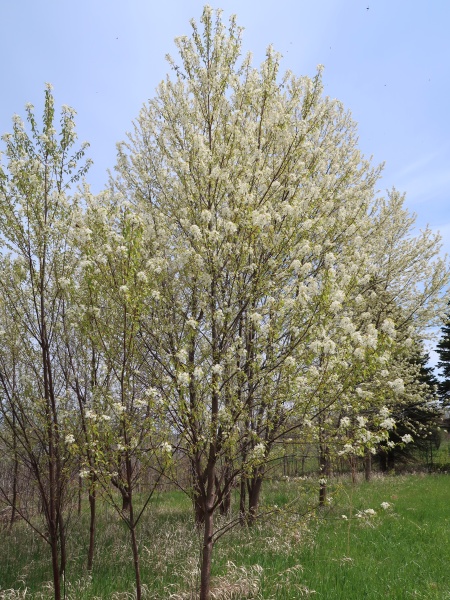 Known to be toxic - Toxic to mammals if ingested.
Known to be toxic - Toxic to mammals if ingested.

Source: OWSL
Prunus pensylvanica
Pin Cherry
Cerisier de Pennsylvanie
Synonyms
bird cherry
fire cherry
wild red cherry
arbre à petites merises
cerisier d'été
cerisier petit-merisier
petit merisier
No seeds available for this plant.
We currently accept seeds for this plant
Bloom Colour: White
Bloom Period: Apr - May
Max Height: 50.0 feet
Max Width: 15.0 feet
Light Condition:
 More than 6 hours of direct sun a day
Soil conditions:
More than 6 hours of direct sun a day
Soil conditions:
 Tolerates medium soil condition
Tolerates medium soil condition
 More than 6 hours of direct sun a day
More than 6 hours of direct sun a day
 Tolerates medium soil condition
Tolerates medium soil condition
Lifespan:
Perennial
plants that will that come back year after year
Gardener Experience:
 Self-seeding
Self-seeding
 Self-seeding
Self-seeding
Landscape Uses:
 Suitable for rock gardens
Suitable for rock gardens
 Suitable for rain gardens
Suitable for rain gardens
 Suitable for rock gardens
Suitable for rock gardens
 Suitable for rain gardens
Suitable for rain gardens
Ecological Benefits:
No ecological benefits information available.
Tolerates:
 Tolerates limestone conditions
Tolerates limestone conditions
 Tolerates juglone conditions
Tolerates juglone conditions
 Tolerates limestone conditions
Tolerates limestone conditions
 Tolerates juglone conditions
Tolerates juglone conditions
Special Features and Considerations:
 This plant causes skin rashes
This plant causes skin rashes
 This plant causes skin rashes
This plant causes skin rashes
Plant Location
Native to Ottawa region: Yes
Distribution according to VASCAN

Ephemeral
Native
Introduced
Excluded
Extirpated
Doubtful
Absent
Thrives in Ecozones
- Taiga Plains
- Atlantic Maritime
- Taiga Shield
- Boreal Plains
- Montane Cordillera
- Prairies
- Boreal Shield
- Boreal Cordillera
- Pacific Maritime
- Mixed Wood Plains
Ecological Benefits
Butterflies Supported by Prunus pensylvanica
- Apatelodes torrefacta (Spotted Apatelodes)
- Catocala ultronia (Ultronia Underwing)
- Complexe Papilio glaucus (Eastern Tiger Swallowtail)
- Eupithecia miserulata (American Common Pug)
- Hyalophora cecropia (Cecropia moth)
- Limenitis arthemis ssp. astyanax (Red Spotted Purple)
- Lomographa semiclarata (Bluish Spring)
- Malacosoma americanum (Eastern Tent Caterpillar)
- Paonias excaecata (Blinded Sphinx)
- Papilio canadensis (Canadian Tiger Swallowtail)
- Satyrium titus (Coral Hairstreak)
- Trichordestra legitima (Striped Garden Caterpillar)
Specialized Bees Supported by Prunus pensylvanica
No bee data available for this plant.
Plants that grow in similar conditions, that bloom at the same time.
Complementary Plants
- No complementary plants found.
Substitute For Non-Native Plants
- Rhamnus cathartica (Common Buckthorn)
- Rhamnus frangula (Glossy Buckthorn)
- Acer japonicum (Japanese Maple)
- Acer platanoides (Norway Maple)
Sowing Information
Download Seed Envelope Labels (PDF)
- Sowing depth: Sow just below surface
- Sow anytime
- Stratification duration: 150 days
- Self-seeding
- Notes: Warm moist stratify 60d, then cold moist stratify 90d.
Harvesting and Seed Sharing
- Harvest start month: July
- Harvesting indicator:
- Berries are ripen and easily fall off or have fallen off
- Harvesting:
- Squeeze berries to extract seeds, wash with soapy water, rinse throroughly
- Seed viability test:
- No test needed before donating
- Packaging measure: Six (6) seeds (eyeball)
- Seed storage:
- Air dry in paper bag or open container, for a few days until crisp
- Shake seeds to move them once in a while to prevent molding
- Cultivar: Yes, do not donate unless you know source, and there are no known cultivars in your garden or at proximity
- No harvesting video available at this time.
Toxicity Notes
Toxic to mammals if ingested.


 Canadensis
Canadensis
